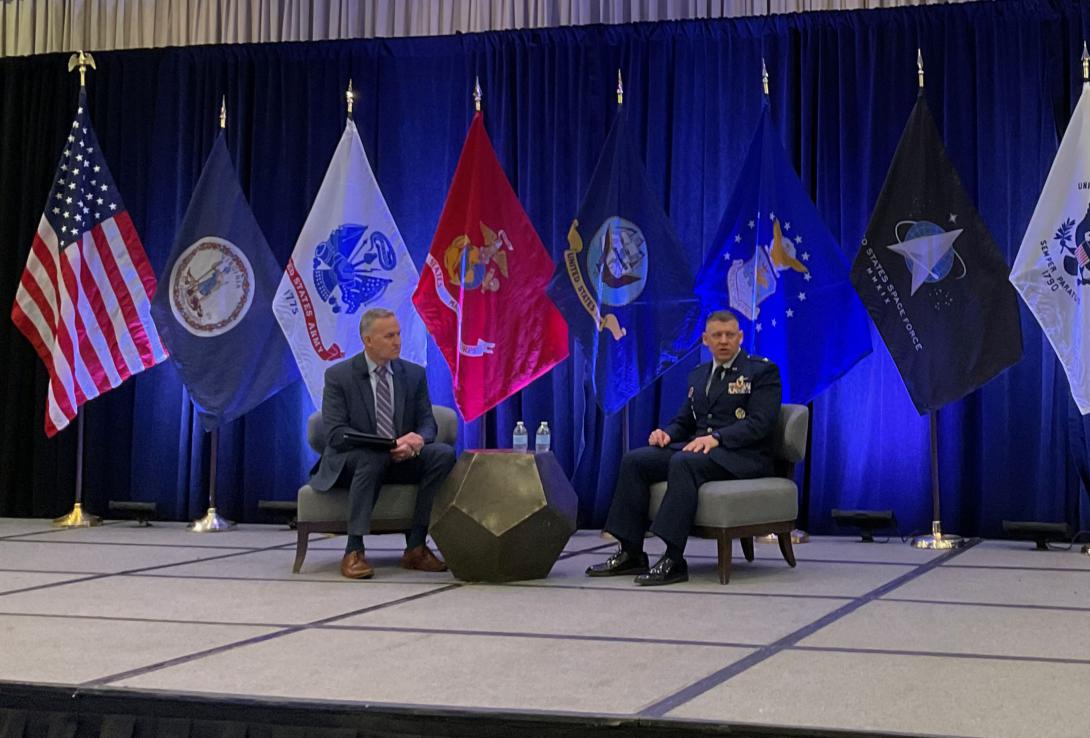Building In-House Cyber Guardians
Given rising adversarial threats, the young and digitally based U.S. Space Force wants to be able to defend against cyber-based attacks on its space-related systems. As such, the service is building internal capabilities and training cyber Guardians to conduct cyber operations.
Space Delta 6, located at Schriever Space Force Base, Colorado, and led by Col. Roy Rockwell, USSF, is leading the efforts. One of the cyberspace squadrons is fully operating, the 64th Cyberspace Squadron at Buckley Space Force Base. And the plan is to add seven more squadrons, reaching a total of nine by the end of FY2027, according to Col. Joseph Wingo, USSF, chief, Cyber and Spectrum Operations (SF/S6C), U.S. Space Force. Col. Wingo, along with moderator Mike Monson, president, Definitive Logic, spoke at the AFCEA NOVA Chapter’s Space Force Industry Information Technology Day on March 21.
“What we're building inside the Space Force is local defender capability,” Col. Wingo said. “We're working through it, we're building tools and utilizing training and building guardians that will be at the CPT [cyber protection team] level. We are building [cyber] Guardians who [will] strike fear in the hearts of our nation's adversary, whether that be for defensive purposes or offensive purposes. That's really the goal.”
And while the service can depend on the nation’s cyber warriors from U.S. Cyber Command (CYBERCOM )—the Cyber Mission Force, including cyber protection teams (CPTs)—the Space Force wants to be able to have its own adroit warriors, the colonel said. And since the Space Force does not have to provide cyber operators to CYBERCOM, the Air Force presents forces on its behalf, the service has to build in-house capability.
“In general, right now, the Space Force does not have a component to U.S. Cyber Command,” Col. Wingo explained. “The 16th Air Force is still our component; we go through the Air Force and so the Air Force is actually providing CPT capability through U.S. CYBERCOM.”
The trick, the colonel emphasized, is to build a strong cyber force with their own expertise, equivalent to the CPTs.
“What we don't want to have, is my fear that we end up building cyber squadrons that are mall cops,” the cyber leader stressed. “Mall cops that are waiting for the special operators of the CPT to come save them. And so, our goal has been to build world-class warfighters. I've told General [Chance] Saltzman and General [DeAnna] Burt, General [Stephen] Whiting, ... that if we build this correctly, we won’t really necessarily need a CPT, there wouldn’t be much that a CPT could provide that you're not already providing for yourself.”
The effort is not without challenges, he continued, including overcoming staffing and funding issues. In order to stand up the cyber squadrons, the lean force, in part, needs to pull from Guardians who are currently performing information technology work and switch them into cyber.
“I don't have guardians transferred out of IT jobs into the cyber squardons yet, and I don't have the training put in place,” Col. Wingo stated. “My shop has been trying to prioritize a lot of the funding for training and getting that stood up, as that's one of those foundational pieces, you really want the schoolhouse waiting for the students, not the students waiting for the schoolhouse.”
As far as vendor tools, the service has added defensive capabilities, including one platform through Kraken, within a modern software development stance. “We are working towards standing capability in terms of the tools [that] we're utilizing as our defensive tool suite, which are developed in a DevSecOps [development security operations] framework inside of Space Systems Command,” Col. Wingo said. “We are working through bringing those online and getting those out there to all the various mission systems that we have.”
What we're building inside the Space Force is local defender capability. ... We are building [cyber] guardians who [will] strike fear in the hearts of our nation's adversary, whether that be for defensive purposes or offensive purposes. That's really the goal.
The colonel has been working on the service’s cyber operations for the last three years. His experience with the Air Force Institute of Technology (AFIT), including with 39th Information Operations Squadron (IOS), has helped position his efforts, he said.
“My mantra, our vision at the 39th IOS that I gave the team when I got there was to build airmen to strike fear in the hearts of our nation's adversary,” the colonel shared. “We are looking to building that capability in the Space Force and push the same guiding foundation. We want that world class capability that's providing persistent cyber monitoring and defense on our mission systems.”
In that regard, Col. Wingo sees artificial intelligence playing a monitoring role. “My vision for cybersecurity of our systems is to have an AI that's doing persistent pen testing of my capability, that's looking for vulnerabilities and looking for ways in before an adversary finds them, allowing me to be able to respond first. That, for me is one of the most powerful ways that from a cybersecurity perspective that I can leverage in AI.”
Notably, the cyber leader is moving to San Antonio this summer, to directly support the 16th Air Force. Erica Gardner, an inter-service transfer from the Army who is finishing up at National Defense University's Eisenhower School this spring, will be taking over as Chief of Cyber and Spectrum Operations.
Eventually, the service will also perform offensive cyber operations, Col. Wingo said.






Comments